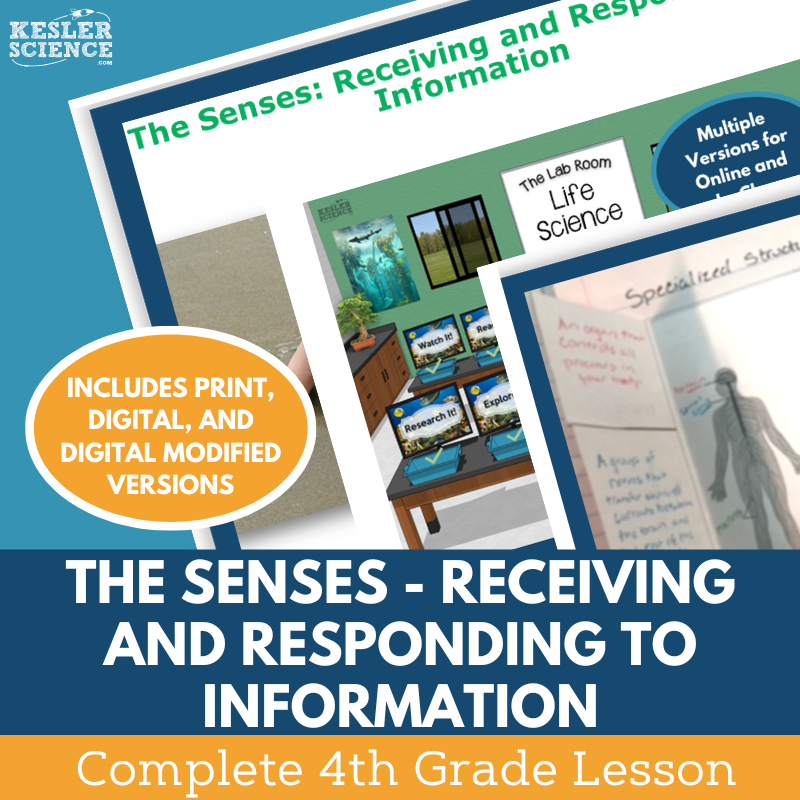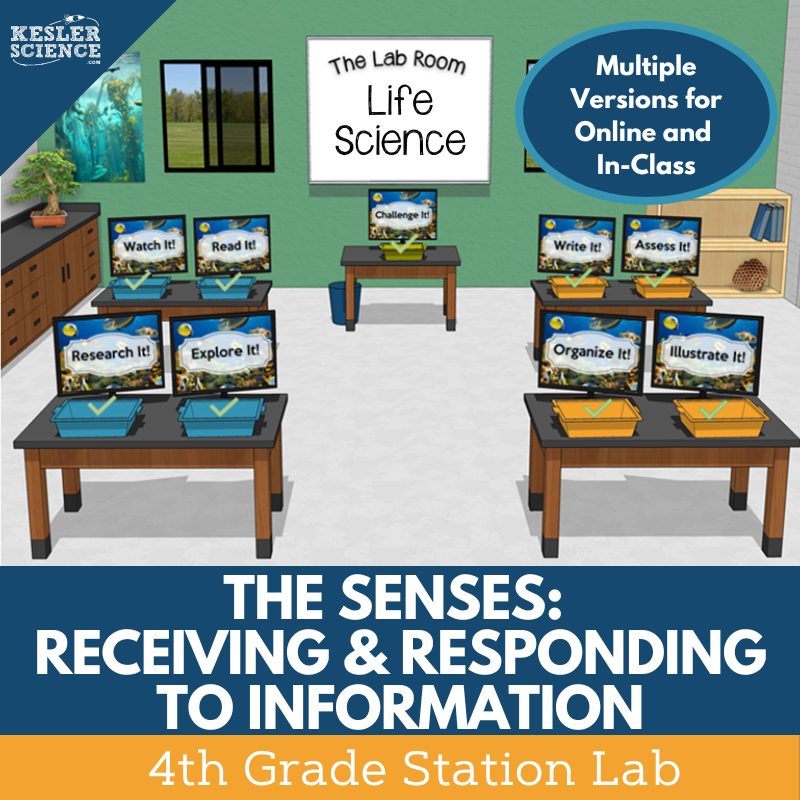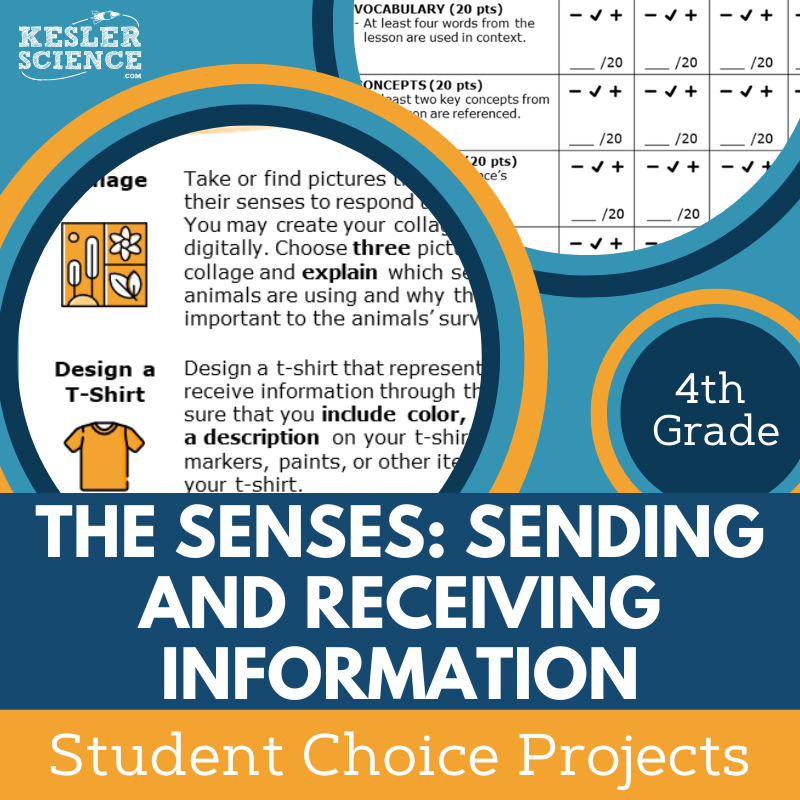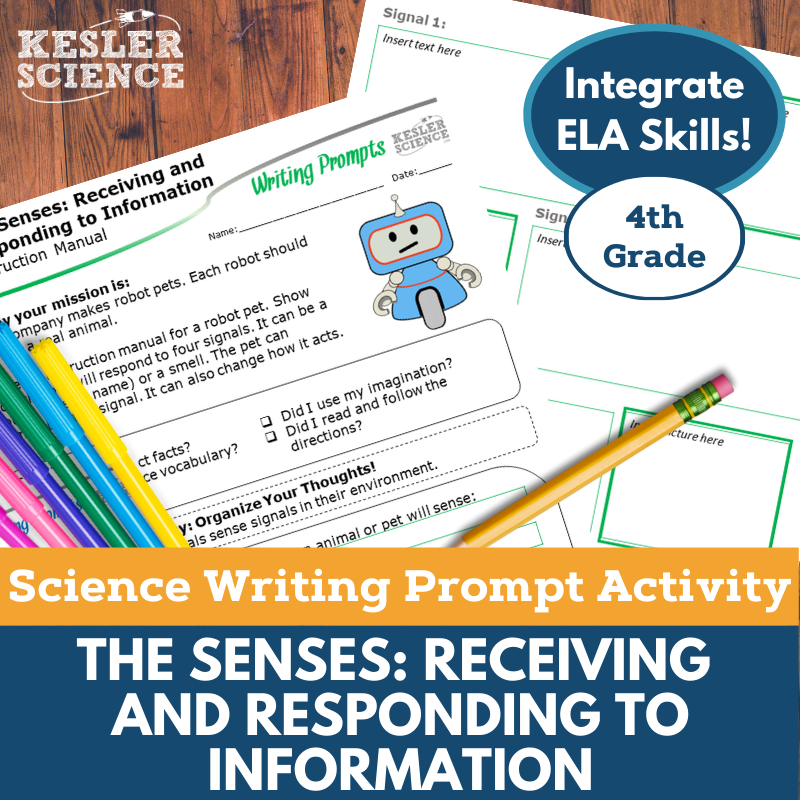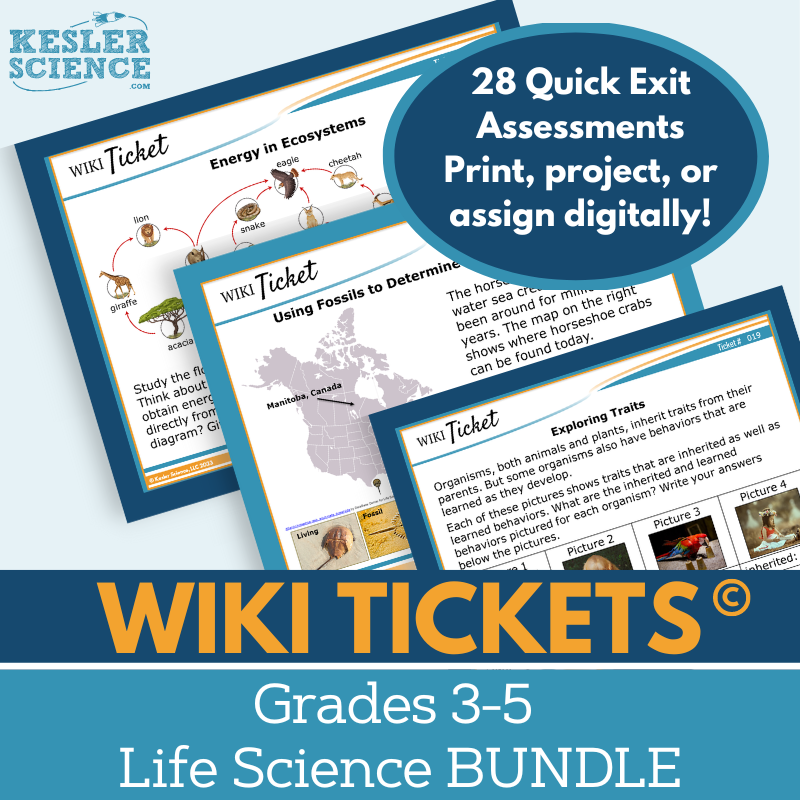Senses Activities for 4th Grade Science
The Kesler Science Senses resources provide 4th grade students with engaging, multimodal activities to explore how we receive and respond to information. The resources below will give students a comprehensive understanding of the senses. All of the following materials are also included in the Kesler Science Membership.
Simplify lesson planning with the Kesler Science Senses: Receiving and Responding to Information 4th Grade Complete 5E Lesson! This fully-developed resource provides all the tools you need for an engaging, multi-day lesson with minimal prep and maximum student involvement. Your students will dive deep into understanding how we receive and respond to different types of information from our environment.
Through a student-led approach, the lesson follows the 5E model—Engagement, Exploration, Explanation, Elaboration, and Evaluation. Students will explore the essential questions about how animals use sensory information and the processes involved. The lesson is flexible, offering materials in digital and printable formats, with resources available in both English and Spanish for greater accessibility.
The included station lab engages all learning styles with nine activity stations that allow students to investigate and demonstrate their knowledge in creative ways. Whether through hands-on experiments, reading, or digital tasks, your 4th graders will stay engaged while gaining a deeper understanding of the senses and their role in survival, growth, and behavior.
Simplify lesson planning with the Kesler Science Senses: Receiving and Responding to Information 4th Grade Complete 5E Lesson! This fully-developed resource provides all the tools you need for an engaging, multi-day lesson with minimal prep and maximum student involvement. Your students will dive deep into understanding how we receive and respond to different types of information from our environment.
Through a student-led approach, the lesson follows the 5E model—Engagement, Exploration, Explanation, Elaboration, and Evaluation. Students will explore the essential questions about how animals use sensory information and the processes involved. The lesson is flexible, offering materials in digital and printable formats, with resources available in both English and Spanish for greater accessibility.
The included station lab engages all learning styles with nine activity stations that allow students to investigate and demonstrate their knowledge in creative ways. Whether through hands-on experiments, reading, or digital tasks, your 4th graders will stay engaged while gaining a deeper understanding of the senses and their role in survival, growth, and behavior.
The Kesler Science Senses: Receiving and Responding to Information Station Lab is designed to keep 4th graders engaged and learning through student-directed activities. These modular, differentiated materials allow students to independently explore how plants and animals have structures that support survival, growth, behavior, and reproduction. With minimal prep, teachers can focus on facilitating student-led discovery.
This station lab includes eight differentiated stations and a challenge station for early finishers. Each activity is designed to support various learning styles, with stations covering input and output tasks. Students can explore concepts through hands-on experiments, reading passages, videos, and digital tasks. The lab also includes assessment opportunities to demonstrate comprehension.
With clear signage, literature, task cards, and resources, the station lab encourages independent or small-group work. Activities can be adapted for both in-person and virtual learning, providing maximum flexibility. Whether through creative projects or hands-on learning, students have the chance to deepen their understanding of sensory processes in an engaging and dynamic way.
The Kesler Science Senses: Receiving and Responding to Information Station Lab is designed to keep 4th graders engaged and learning through student-directed activities. These modular, differentiated materials allow students to independently explore how plants and animals have structures that support survival, growth, behavior, and reproduction. With minimal prep, teachers can focus on facilitating student-led discovery.
This station lab includes eight differentiated stations and a challenge station for early finishers. Each activity is designed to support various learning styles, with stations covering input and output tasks. Students can explore concepts through hands-on experiments, reading passages, videos, and digital tasks. The lab also includes assessment opportunities to demonstrate comprehension.
With clear signage, literature, task cards, and resources, the station lab encourages independent or small-group work. Activities can be adapted for both in-person and virtual learning, providing maximum flexibility. Whether through creative projects or hands-on learning, students have the chance to deepen their understanding of sensory processes in an engaging and dynamic way.
The Kesler Science Senses: Sending and Receiving Information Student Choice Projects give 4th grade students the freedom to select from a variety of project options that match their preferred output style. With six project choices plus a “design your own” option, students can express their learning creatively. Teachers can use the provided grading rubric or modify it to suit specific assessment needs, making the projects flexible for different classroom settings.
These student-centered projects promote personalized learning and include differentiated options to accommodate students needing support, as well as those seeking a challenge. The resources offer nine distinct project choices, along with editable rubrics that assess vocabulary, concepts, presentation, and accuracy, all designed to enhance student engagement and creativity.
The Student Choice Projects are designed for easy implementation with standard classroom supplies like paper, markers, and scissors. Many projects can be completed digitally, offering teachers and students flexibility. Whether for in-class or virtual learning, the projects cater to a variety of learning styles, ensuring all students can succeed.
The Kesler Science Senses: Sending and Receiving Information Student Choice Projects give 4th grade students the freedom to select from a variety of project options that match their preferred output style. With six project choices plus a “design your own” option, students can express their learning creatively. Teachers can use the provided grading rubric or modify it to suit specific assessment needs, making the projects flexible for different classroom settings.
These student-centered projects promote personalized learning and include differentiated options to accommodate students needing support, as well as those seeking a challenge. The resources offer nine distinct project choices, along with editable rubrics that assess vocabulary, concepts, presentation, and accuracy, all designed to enhance student engagement and creativity.
The Student Choice Projects are designed for easy implementation with standard classroom supplies like paper, markers, and scissors. Many projects can be completed digitally, offering teachers and students flexibility. Whether for in-class or virtual learning, the projects cater to a variety of learning styles, ensuring all students can succeed.
The Kesler Science Senses: Receiving and Responding to Information Science and ELA Integrated Writing Activity invites 4th grade students to explore their knowledge of the senses through a creative and engaging instruction manual format. This activity encourages students to connect science concepts to writing, helping them expand their understanding while refining their communication skills. Designed for both in-class and virtual learning, it ensures students stay engaged, regardless of the learning environment.
This standards-aligned activity, grounded in TEKS and NGSS, offers a versatile tool for elaboration or review. It requires minimal prep and is ideal for differentiating learning, making it a perfect fit for various classroom needs. With resources like a full-sized handout, digital interactive version, and ready-to-use rubrics, teachers have everything they need to assess and support student progress.
Whether used for cross-curricular integration, formative assessments, or differentiated practice, the Senses: Receiving and Responding to Information Writing Activity fosters creativity and enhances critical thinking. It’s an excellent choice for both independent or group work and can be applied to a range of academic purposes, including extra credit, student choice projects, and make-up work.
The Kesler Science Senses: Receiving and Responding to Information Science and ELA Integrated Writing Activity invites 4th grade students to explore their knowledge of the senses through a creative and engaging instruction manual format. This activity encourages students to connect science concepts to writing, helping them expand their understanding while refining their communication skills. Designed for both in-class and virtual learning, it ensures students stay engaged, regardless of the learning environment.
This standards-aligned activity, grounded in TEKS and NGSS, offers a versatile tool for elaboration or review. It requires minimal prep and is ideal for differentiating learning, making it a perfect fit for various classroom needs. With resources like a full-sized handout, digital interactive version, and ready-to-use rubrics, teachers have everything they need to assess and support student progress.
Whether used for cross-curricular integration, formative assessments, or differentiated practice, the Senses: Receiving and Responding to Information Writing Activity fosters creativity and enhances critical thinking. It’s an excellent choice for both independent or group work and can be applied to a range of academic purposes, including extra credit, student choice projects, and make-up work.
The Kesler Science Life Science WIKI Tickets provide fun, easy formative assessments for 3rd–5th grade science. This set includes 28 engaging exit tickets aligned to NGSS and TEKS, covering topics like ecosystems, traits, life cycles, and food webs.
Each topic features five formats: a full-screen display for projection, three printable handout sizes, and an interactive digital version compatible with PowerPoint and Google Slides. A bonus table of contents file ensures easy standard alignment.
WIKI Tickets (“What I Know Is”) serve as exit tickets, bellringers, or quick checks for understanding, making them a flexible tool for both in-person and virtual learning environments.
The Kesler Science Life Science WIKI Tickets provide fun, easy formative assessments for 3rd–5th grade science. This set includes 28 engaging exit tickets aligned to NGSS and TEKS, covering topics like ecosystems, traits, life cycles, and food webs.
Each topic features five formats: a full-screen display for projection, three printable handout sizes, and an interactive digital version compatible with PowerPoint and Google Slides. A bonus table of contents file ensures easy standard alignment.
WIKI Tickets (“What I Know Is”) serve as exit tickets, bellringers, or quick checks for understanding, making them a flexible tool for both in-person and virtual learning environments.
Year-Round Resources
These year-round activities will increase your students' understanding of many middle school science topics. All of these activities are also included in the Kesler Science Membership.
Visual Data & Graphing
You're not alone if your students struggle with understanding graphs, charts, and tables. It's a skill that takes an enormous amount of practice. This resource will help students build a strong foundation in analyzing data and creating their own data visualizations.
Bell Ringers and Warm-Ups
These middle school science bell ringers are an excellent way to engage your students as soon as they walk into your classroom. This comprehensive FULL YEAR resource includes everything you need to start off each science class with an interesting warm-up activity.
Review Board Games
Each game board has been carefully designed to keep students engaged. There are 10 different action spaces on each board and dozens of question cards. All of the actions are related to science concepts and keep the students motivated throughout the game.
Each game is ready to play. Simply print out the board and the cards and let the students enjoy reviewing nine different units.
Essential Questions
Below are the essential questions associated with the lessons and activities included in this unit. This topic is only one of more than 100 middle school science topics included in the Kesler Science Membership.
-
Describe the ways in which we receive different types of information.
-
What has to happen in the body for animals to use the information they get from their environment?
Kesler Science Membership
Imagine never having to search for another middle school science lesson again. The membership gives you access to ALL of the Kesler Science products in one place (Yes, including everything above).
Say goodbye to long hours of lesson prep.

